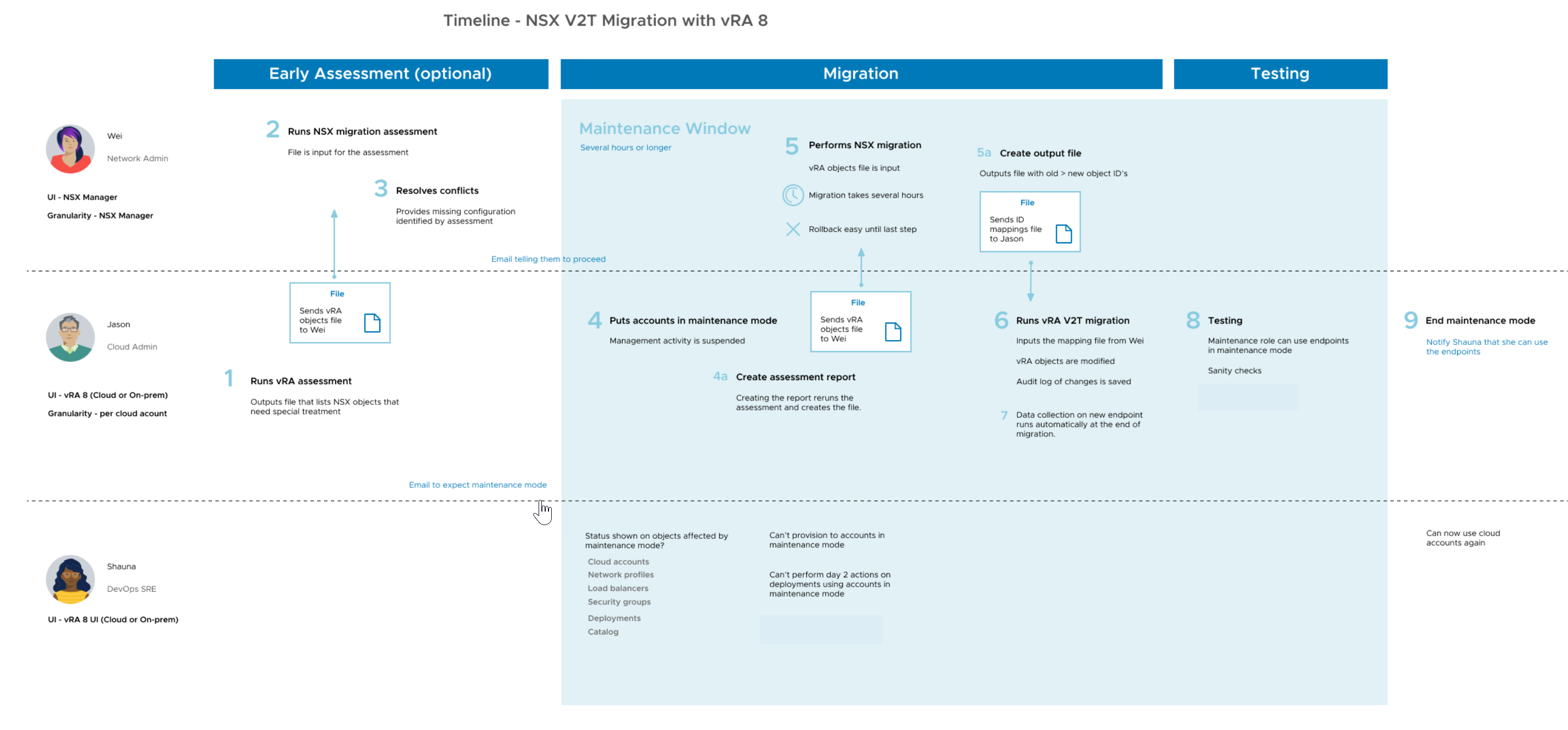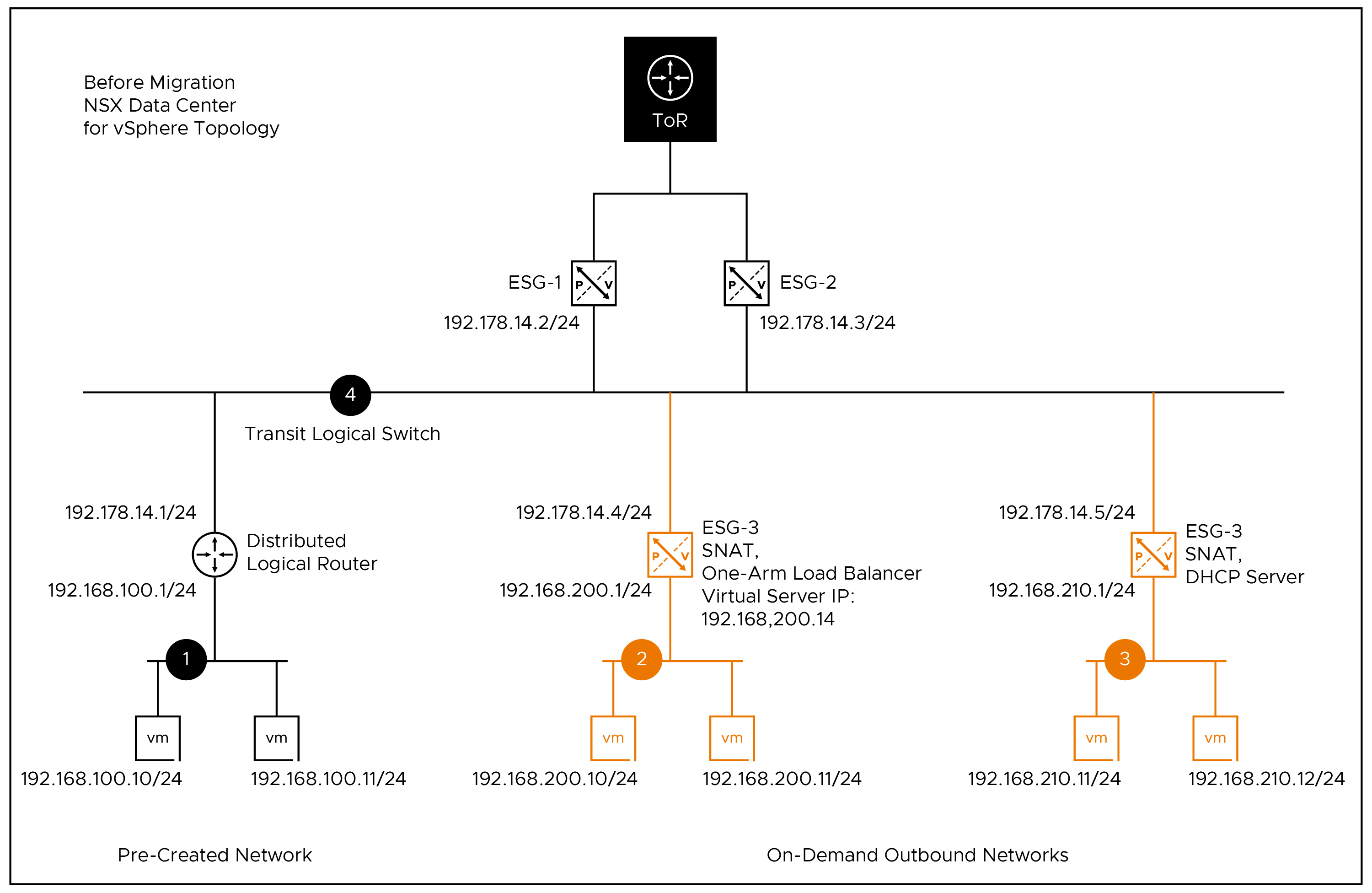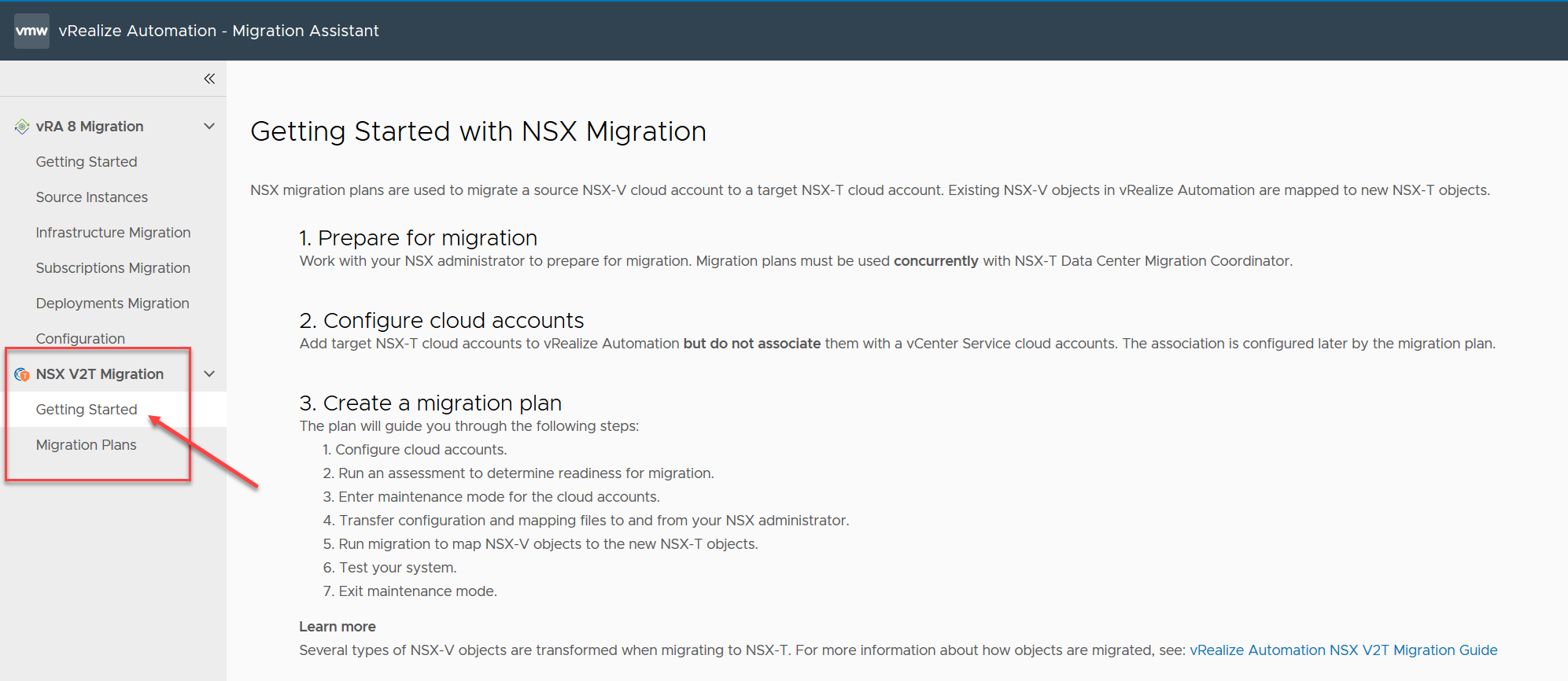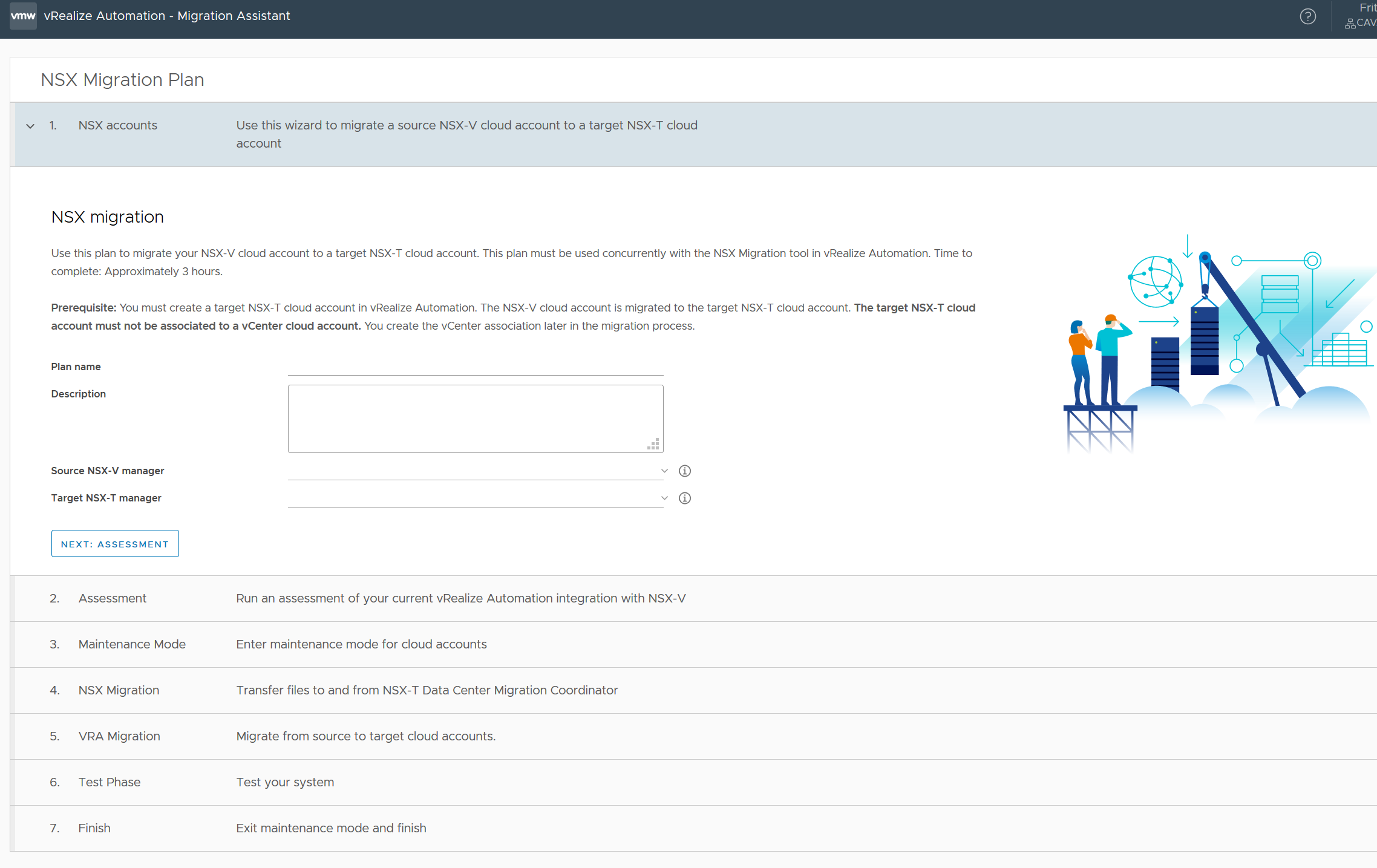vRealize Automation NSX-V to NSX-T migration enables you to take advantage of the NSX-T Data Center Migration Coordinator from within the constructs of vRealize Automation. While the migration process is primarily run in the vRealize Automation environment, there are several interconnected actions within the process that involve both the vRealize Automation administrator and the NSX administrator working together to share information.
You can migrate your NSX-V Manager (NSX-V) to NSX-T Manager (NSX-T) by using the prescriptive vRealize Automation NSX-V to NSX-T migration assistant in vRealize Automation. The migration assistant consists of a getting started page and sequential migration plan pages.
Each source NSX-V cloud account requires a separate migration plan in the vRealize Automation NSX-V to NSX-T migration assistant.
By migrating your NSX-V cloud accounts and their related objects to NSX-T, you can take advantage of the many enhanced features and functions of NSX-T itself and as integrated within vRealize Automation.
While you work with the migration plan in vRealize Automation, there is a point in the process where the vRealize Automation administrator and the NSX administrator must share files with one another as input to, and output from, the NSX-T Data Center Migration Coordinator utility. The migration plan on-screen help informs you when you and the NSX administrator need to communicate with one another to share the needed files. The following diagram illustrates the basics of this administrator relationship within the migration process workflow.

The vRealize Automation NSX-V to NSX-T migration assistant is available for migrating NSX-V cloud accounts and their related objects to NSX-T within your current vRealize Automation release. It is not available for migrating NSX cloud accounts from one vRealize Automation release to another.
This guide is meant for use with the vRealize Automation NSX-V to NSX-T migration assistant and its prescriptive migration plans. Use this guide to supplement the on-screen instructions provided in the vRealize Automation NSX-V to NSX-T migration plan on-screen guidance.
For information about the related NSX-T Data Center Migration Coordinator utility, see NSX-T Data Center Migration Coordinator Guide in VMware NSX product documentation.
For more information about the benefits of migrating to NSX-T, see the Migrate to VMware NSX-T product page and What's New in NSX-T.
Supported topologies
vRealize Automation supports migration of NSX-V objects to NSX-T release 3.1.1 or later objects, including NSX-T release 3.1.3. It does not support migration of NSX-V objects to NSX-T release 3.1.0 or earlier objects.
The NSX-V to NSX-T migration process migrates to NSX-T Policy API. It does not migrate to NSX-T Manager API.
vCenter 6.7 associations are migrated to vCenter 6.7. vCenter 7.0 or greater associations are migrated to vCenter 7.0 or greater.
- Deploy your current vRealize Automation 8.x release.
- Migrate your workloads from vRealize Automation 7.6 to your current vRealize Automation 8.x release by using the migration wizard. See the vRealize Automation 8 Transition Guide for your release.
- Deploy the NSX-T application.
- Add an NSX-T cloud account to your current vRealize Automation 8.x release environment and map it to an NSX-T endpoint.
- Create and run an NSX-V to NSX-T migration to move your workloads from NSX-V to NSX-T. See this guide.
- When a new vRealize Automation 8.x release is made available, upgrade to it normally. See the vRealize Automation 8 Transition Guide for your release.
The following topologies are supported and available for migration:
- Existing networks (Static and DHCP)
- Routed networks (Static and DHCP)
- Private networks (Static and DHCP)
- Existing security groups
- On-demand security groups
- On-demand one armed load balancers on existing networks
- Outbound networks (Static and DHCP) with or without shared gateway
- User-defined DNAT rules are not supported
- Load balancers with outbound networks are not supported
- Machine (DHCP IP) connected to an outbound network
- Multiple outbound networks connected through a gateway
- Deployments that contain outbound or private networks that use isolation policy as an on-demand security group
- Private networks that are isolated by a security group
- Outbound networks that are isolated by a security group
- On-demand routed networks with DHCP and one-armed load balancer
- On-demand and existing security groups and load balancer
- On-demand outbound networks with DHCP and load balancer
- NSX-V networks associated with vCenter 6.7 and CVDS 6.7. Migration is to NSX-T 3.1.1 or greater with vCenter 6.7 and NVDS or vCenter 7.0 and NVDS.
- NSX-V networks associated with vCenter 7.0 and CVDS. Migration is to NSX-T with vCenter 7.0 and NVDS.

For related information about supported topologies, see Topologies Supported for Integration with vRealize Automation in the NSX-T Data Center Migration Coordinator Guide in the VMware NSX product documentation.
Unsupported topologies
The following topologies are not supported for migration:
- Deployments that contain NAT or DNAT rules configured on the NAT or gateway component
- Routed networks with shared T1
- One-arm load balancer or inline load balancer on any on-demand network
- On-demand inline load balancers on existing networks
- Deployments that use the public network type
- Deployments that reference vSphere network types.
If the assessment step in the migration plan encounters an unsupported topology, it generates a validation error.
Running data collection if NSX-V and vCenter objects were migrated from vRealize Automation 7.x to vRealize Automation 8.x
If any deployments in your vRealize Automation environment were migrated from vRealize Automation 7.x to vRealize Automation 8.x, you must run data collection on their NSX-V and vCenter cloud accounts before you create an NSX-V to NSX-T migration plan. This step is needed to collect information about migrated resources such as load balancers and security groups.
Accessing the vRealize Automation NSX-V to NSX-T Migration Assistant
This section provides and overview of the migration process.
- Using your vRealize Automation administrator credentials and migration role privileges, log in to your vRealize Automation - Cloud Services Console and click the vRA Migration Assistant service tile.

- Click Getting Started from the NSX V2T Migration menu. To gain an overview of the process, review the information on the Getting Started page. For more information, see Getting started with vRealize Automation NSX-V to NSX-T migration.

- When you are ready to start the migration, click Migration Plan from the NSX V2T Migration menu and then click New Plan.
- The migration plan wizard provides the sequential instruction you need to advance through each step in the process. For more information, see Creating and running the vRealize Automation NSX-V to NSX-T migration plan.
